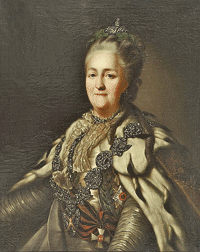
Princess Sophie Friederike Auguste von Anghalt-Zerbst Dornburg, later known as Catherine the Great, was born in the Kingdom of Prussia in Stettin, Pomerania April 21, 1729. Her father was a Prussian general. Two of her first cousins were Kings of Sweden, Gustav III, and Charles XIII. She was not Russian and had no legal claim to the Russian crown.
At age 15 she was engaged to Duke Karl Peter Ulrich who was ugly-looking and eventually disfigured by smallpox. He was feeblemi

nded, childish, and sadistic. As the grandson of Peter the Great, he became Tsar Peter III of Russia. Their wedding took place August 21, 1745 in St. Petersburg. What followed was 16 years of misery when Peter took a mistress and tormented Catherine with constant insults.
Increasingly lonely and isolated, she spent hours reading and riding her horses. Intelligent, young, beautiful, she was described by Chevalier d’Eon, a secret agent, as “romantic ardent, with bright glassy hypnotic look, thoughtful and friendly.” It is believed that Sergei Saltykov fathered her three pregnancies, but only one son, Paul, lived.
In December 1761, Peter became tsar. Catherine was fully ready to strike. Aleksey Orlove, then Catherine’s lover, had been formulating plans to overthrow Peter. The carefully-planned coup was swift and within hours Catherine had herself declared empress and secured the city. Seven days later, Peter was dead. He had signed the act of abdication earlier and died at dinner, under circumstances never satisfactorily explained.
Empress Catherine II ruled for 34 years. A Russian historian wrote that “all would agree that Catherine’s epoch was the happiest for Russian citizens. Virtually all would prefer to have lived then (rather) than at any other time.” She said she loved peace and yet she oversaw seven wars and masterminded the complete dismemberment of Poland. She presented herself as the Roman goddess of wisdom, Minerva Triumphant, and she was an autocrat ruling for “the good of each and all.” Russia became known as one of the great powers of Europe.
Catherine began her reign full of great ideas. Her years of reading gave her high aspirations. She was a tireless worker and her motto was “Useful.” She got up early, drank strong black coffee, rubbed her face with an ice cube, and wrote for several hours. Then she would meet with her ministers. Dinner was at 2 p.m. and was usually plain. She had frequent headaches and digestive disorders and wasn’t interested in food. Her evenings were filled with theater, music, or card-playing and she retired early.
Catherine thought that Russia could benefit from German orderliness and industry. Some 20,000 arrived in the first wave of immigration and by the beginning of the 20th Century, almost half a million German-speaking Russians were living along the Volga. Catherine presented inoculation for small pox as good for her subjects. She cleaned up Moscow’s water supply and created institutions to care for foundlings and treat venereal disease. She founded a national system of free public schools and sent promising pupils to study abroad. Historian Isabel de Madariage said that “Where Peter the Great used terror, Catherine the Great used persuasion.” In restructuring Russia, Catherine encouraged the cultivation of new crops such as potatoes.
She was lustful and took as many as 20 lovers and each one lasted fairly long, ranging from one to 12 years. Her love letters show that she believed her lovers to be absolute ideals. She was emotionally vulnerable which came from feeling achingly lonesome.
By 1796, the year she died following a stroke, Russia contained more than nine million male serfs because females weren’t counted. They lived at the mercy of their masters on whom there were no legal or social constraints. Russia was ripe for revolution.

